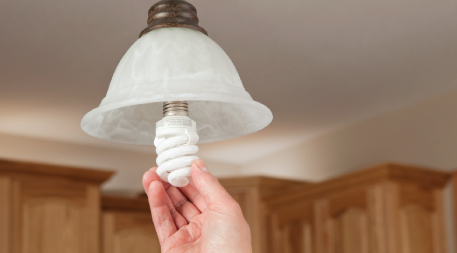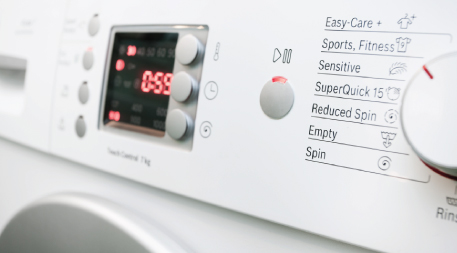April 25, 2013 — When it comes to reducing fossil fuel use, increasing energy efficiency has obvious appeal: help the environment, boost energy security and save money, too — without the grit-your-teeth-and-get-by-without attitude of 1970s-style energy conservation. Not only that, but boosting the amount of work we squeeze out of each kWh or Btu is the cheapest, most plentiful and fastest tool we have for moving toward a more sustainable energy future. Many efficiency fixes, experts point out, save so much it would be foolish to ignore them.
Americans have made some moves to enhance efficiency: Per capita energy use has fallen by 14 percent in the past three decades in the U.S., and since 1970 the energy necessary to create each dollar of GDP has been halved. Still, based on comparisons with other countries, that figure could well be halved again. And a report a few years ago by the National Academies suggested Americans could reduce energy use 17 to 22 percent by 2020 and 25 to 31 percent by 2030 if we adopt existing and emerging energy efficiency technologies.

Why is energy efficiency such a tough sell? Human behavior, bureaucracy and a lack of capital all get in the way of reaping the economic and environmental gains it has to offer. ©iStockphoto.com/BanksPhotos
Why isn’t this “low-hanging fruit,” as efficiency is invariably called, being plucked? In the face of logic, incentives, regulatory mandates, new efficiency-enhancing technologies and even moral imperative, consumers remain surprisingly ambivalent about, or even muddled by, the options. Part of the problem is how human behavior often stymies better intentions. Another factor is the more banal reality that bureaucracy and a lack of capital can slow any revolution in its tracks, no matter how cost-effective it might be.
“The potential to reduce the energy we waste is compelling,” Kenneth J. Ostrowski, a senior partner at global management consulting firm McKinsey & Co., said in announcing a 2009 study of the U.S. economy. “However, to unlock the full potential, we need a coordinated national and regional strategy to overcome barriers and scale up the deployment of existing energy efficiency technologies.”
Consider the Value
First, take a step back and consider the value efficiency offers. In an influential study published in 2008, psychologists Gerald T. Gardner and Paul C. Stern assessed the impact of around 30 steps households could take toward increasing their energy efficiency, all using currently available technologies. The sum of the efforts, they found, could cut U.S. home energy use by up to 30 percent. Since residences account for nearly one-third of total energy use, these savings could trim 11 percent from overall U.S. energy consumption.
In its 2009 report, McKinsey identified waste and other savings opportunities amounting to 23 percent of the U.S. energy pie, excluding the transportation sector. The cost of energy-saving upgrades, McKinsey found, could be entirely paid for within a few years by the resulting reduction in spending on energy. For a total investment of $520 billion, the U.S. could trim some $1.2 trillion from its energy costs by 2020. “Energy efficiency should be elevated to a national priority,” said Ostrowski.
In his 2010 book Invisible Energy, Goldstein estimated savings of 80 percent are possible by 2050 if we include technologies now in the pipeline, as well as those likely to be introduced given what we know about the pace of innovation.
The savings would be greater still if the calculation considers future innovation, says David Goldstein, energy program co-director for the Natural Resources Defense Council. In his 2010 book Invisible Energy, Goldstein estimated savings of 80 percent are possible by 2050 if we include technologies now in the pipeline, as well as those likely to be introduced given what we know about the pace of innovation.
Commenting on a National Academy of Sciences study estimating that energy savings of 30 percent are possible with today’s technology, Goldstein points out that by factoring in improvements in these technologies, the efficiency resource balloons in size to trillions of dollars of growth potential.
Culprit: Confusion
So if these gains are waiting to be made, what’s holding up the great efficiency revolution?
One culprit seems to be confusion. Consumers face a challenge connecting big, abstract gains with more familiar day-to-day decisions, such as installing CFL lightbulbs. And Americans are — for now, at least — so muddled about energy and efficiency that we’re largely unable to identify best choices about how to cut consumption.
In 2009, a research team led by Shahzeen Attari at Columbia University’s Center for Research on Environmental Decisions surveyed 505 subjects to assess their perceptions of energy consumption and savings for a variety of household, transportation and recycling activities. The team found that subjects sometimes overstated the impact of visible actions that offered relatively little energy savings, while profoundly underestimating the impact of less-visible steps that saved 10 or even 100 times more energy. While the test did not formally include cost estimates, the data suggest that respondents tended to underestimate choices with bigger impacts that were more costly.
Interestingly, respondents who identified themselves as eco-minded tended to be less accurate than the general public. Emphasizing that the study wasn’t testing the causes of these misconceptions, Attari points out, “The well intentioned may focus on behaviors that they do, and pay less attention to the ones they don’t do.”
But the study offers one piece of the puzzle to help encourage efficiency: Enlighten consumers about their consumption. Some utilities, for example, are tinkering with household gizmos designed to deliver data to residents so they can see their energy use. That kind of personalized instant feedback on gains made may be just what people need to make pursuing energy efficiency seem worth their while — particularly if reducing energy use is tied to something that makes a difference to them.
High costs, such as the price tag for insulation or a new, energy-efficient furnace, can be a barrier to major green upgrades.
“Go after what matters most to a consumer,” says Attari. “If they care about security, talk about energy independence. If they care about economics, talk about cost savings. If they care about their grandkids, talk about protecting future generations. If they care about biodiversity and species extinction, talk about polar bears.”
Set the Pace
Consumers are quick to state a willingness to pay for green features. But in practice, another impediment to adopting energy efficiency measures is our aversion to paying large amounts up front, even if the investment promises long-term savings. High costs, such as the price tag for insulation or a new, energy-efficient furnace, can be a barrier to major green upgrades.
Some cities have pioneered an innovative solution to this problem. Adapting a model historically used to pay for sewer systems, sidewalks and other public works, planners in Berkeley, Calif., devised an approach — called Property Assessed Clean Energy, or PACE — that financed the up-front costs of big-ticket efficiency investments by issuing a bond. Property owners could, in turn, borrow those public funds to pay for green upgrades. To pay back the loan, homes that tapped into PACE funds see their taxes rise incrementally over 20 years.
“PACE helps consumers get past the hurdle of paying up-front costs,” said Claire Danielle Tomkins, director of research at the Carbon War Room, at the Business Climate 2010 conference in New York.
To date, more than 20 states have passed laws enabling PACE programs. Perversely, however, Washington stymied the progress of PACE deployments. In the wake of the global financial crisis, federal authorities blocked mortgages attached to PACE bonds, arguing that the added payments increase a borrower’s monthly costs and thereby add risk to still sickly mortgage markets.
Rebound
Interestingly, thanks again to human nature, even implementing measures that improve efficiency will not necessarily result in reduced energy use.

In one study, households that installed high-efficiency washing machines also boosted washing volume 5.6 percent. ©iStockphoto.com/alexandrumagurean
One challenge is something called the “rebound effect.” By definition, greater efficiency lowers the cost to use a technology. But people tend to consume more of something as it gets cheaper. When these two truths collide, efficiency gains can be diluted by increases in use. One study found that households with high-efficiency washing machines boosted the volume of washing they did on average by 5.6 percent. This increase didn’t negate the 40 to 50 percent reductions in water and energy consumption the units delivered, but it did erode total efficiency gains, according to a 2008 RAND paper by economist Lucas Davis.
For another twist on how human nature can stymie efficiency’s efforts to cut energy use, consider America’s love affair with big, fast cars. The technology to dramatically boost vehicle efficiency has been progressing for decades, but technology upgrades that could have saved energy have instead gone to soup up performance. While mileage barely budged between 1990 and now, average horsepower surged 77 percent, to around 230 today. As a result, today’s mild-mannered Toyota Sienna minivan offers about as much horsepower as Ford’s fastest ’72 Mustang.
More Carrots, More Sticks
Alas, there is no single fix for efficiency elusiveness. Logjams like the PACE policy must be dismantled one by one. And because human behavior is so complex, approaches to altering it must take many forms.
For now, incentives are the most politically saleable strategy to induce efficiency savings. As part of the 2009 stimulus bill, the U.S. Department of Energy doled out hundreds of millions to boost efficiency programs.
More vigorous mandates are making a comeback, too. Most visible, perhaps, has been the rollout of higher mileage standards for cars. And in 2010, DOE announced dozens of tough penalties against companies selling appliances, plumbing and lighting without certifying that they meet energy and/or water efficiency standards. Such well-crafted rules promise to speed change while obviating many of the psychological traps that can distract consumers. When we can’t opt for a less-efficient technology, our purchasing decisions get easier.
There may even be a public appetite for a yet heavier regulatory hand. A national survey conducted by the Mellman Group for the Union of Concerned Scientists suggests consumers may prefer tougher mileage rules. The study found that about 74 percent of voters favor tougher federal goals requiring that average fuel efficiency rise to 60 mpg by 2025. Two-thirds supported the goal even if it meant a $3,000 premium on the sticker price, assuming that could be recouped in savings at the pump within four years.
Perhaps the biggest motivator of all could end up to be the market. The sharp oil price spike of 2008 caused an unprecedented stampede away from gas-guzzling vehicles and triggered broader efforts to cut energy use. Similar increases in the cost of electricity or natural gas could do much to motivate consumers to cut back by improving their energy efficiency.
Advocates for a tax on carbon emissions generated by energy use argue such a fee would trigger the adoption of energy efficiency measures in an orderly fashion by preventing such on-again, off-again shifts toward efficient technologies. Better to create an incentive to put efficient systems into place ahead of time, they argue, than to wait for unpredictably high energy prices to return and force these shifts chaotically.
Indeed, better we all learn efficiency-improving behaviors while we can afford to. ![]()
A version of this feature originally appeared in the Fall 2010 issue of Momentum magazine, Ensia’s predecessor.
Ensia shares solutions-focused stories free of charge through our online magazine and partner media. That means audiences around the world have ready access to stories that can — and do — help them shape a better future. If you value our work, please show your support today.
Yes, I'll support Ensia!
